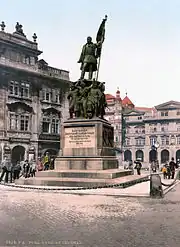.jpg.webp)

Emanuel Max, after 1876: Ritter von Wachstein (19 October 1810, Janov[1] – 22 February[2] 1901, Prague) was a German-Czech sculptor. His brother was the sculptor Josef Max.
Life
Max was born into a family of sculptors and woodcarvers and received his first lessons from his father. He later studied painting at the Academy of Fine Arts, Prague, under Joseph Bergler and František Kristian Waldherr. The academy did not have a sculpture department at that time, so he also studied at the Vienna Academy of Fine Arts with Johann Nepomuk Schaller and Franz Käßmann (1760–1833).
From 1839 to 1849, he lived in Italy, where he improved his knowledge of the old masters and came under the influence of newer masters, such as Antonio Canova and Bertel Thorvaldsen. He also honed his technical skills by carving Carrara marble. When he returned to Prague, he opened his own successful sculpting workshop and got married.
He was named a Knight of the Order of Franz Joseph in 1858 and a member of the Order of the Iron Crown (Class III) in 1875. The following year, he was knighted by Emperor Franz Joseph and given the noble appellation "von Wachstein".[3]
Selected works
- Statue of Saint Adalbert praying for rain, which won him a fellowship to study in Italy from the Klar Foundation.
- Monument to Marshal Radetzky, done with the assistance of his brother Josef, from sketches by Christian Ruben.
- Portrait busts of Mozart, Julius Vincenz von Krombholz and Alois Klar.
- Memorial for Karl Egon II in Křivoklát Castle
- Monument to Karl Philipp, Prince of Schwarzenberg at Krásný Dvůr Castle
- Statue of the Archangel Raphael for the chapel at the Institute for the Blind, now in the National Museum.
- Statues of Henri, Duke of Rohan and Godfrey of Bouillon for Sychrov Castle
- Sculptures on the Charles Bridge. (Pièta; Francis of Assisi as Saint Francis Seraphicus, accompanied by angels; Saint Christopher with the Infant Jesus; Calvary)
References
- ↑ Toman Prokop, Nový slovník československých výtvarných umělců (New Dictionary of Czechoslovak Artists), Vol.2, Rudolf Ryšavý, Prague (1950)
- ↑ Miloš Szabo, Pražské hřbitovy. Olšanské hřbitovy III., Libri, Prague (2011) ISBN 978-80-7277-487-6
- ↑ Karel Vavřínek, Almanach českých šlechtických a rytířských rodů 2008 (Almanac of Czech Noble Families) Martin, Brandýs nad Labem (2007) ISBN 978-80-85955-36-1
Further reading
- Emanuel Max, Zweiundachtzig Lebensjahre. (Eighty-two Years of Life), H. Dominicus, Prague 1893
- Ottův slovník naučný, (Otto's encyclopedia), Max Emanuel, sochař. Vol.16, pg.1017
- Petr Wittlich, Sochařství, in: Praha národního probuzení (Prague, National Awakening) (ed. Emanuel Poche). Panorama, Prague 1980.
- Naděžda Blažíčková-Horová: "Emanuel Max", in: Nová encyklopedie českého výtvarného umění,(New Encyclopedia of Czech Fine Arts), Academia, Prague 1995, Vol.2, pgs.496 - 497. ISBN 80-2000-522-6
- Pavel Vlček et al., Umělecké památky Prahy. Díl I., Staré město. (Artistic Monuments of Prague) 2 vols. Academia, Prague 1996 ISBN 80-2002-107-8
External links
- Wachstein, Emanuel Max. Zweiundachtzig Lebensjahre digitalized by the Prague National Technical Library
- Zastavení s bratry Maxovými – Documentary from Czech Television on the Max brothers and the Charles Bridge, hosted by Prof. František Dvořák.
- List of works about Emanuel Max at the Czech National Library.
